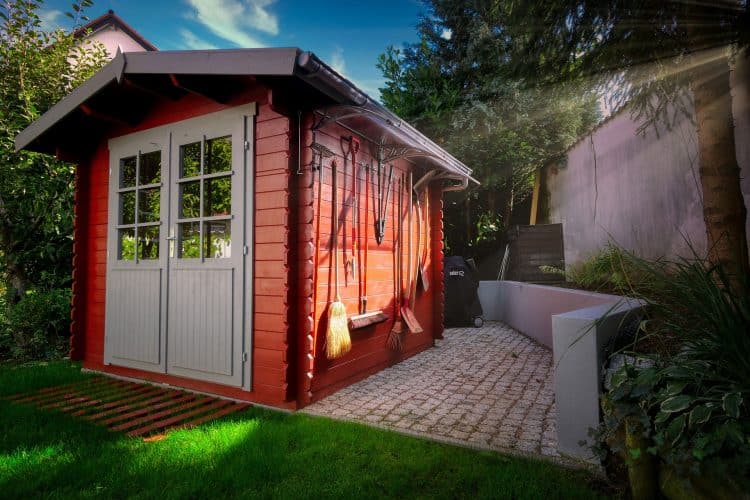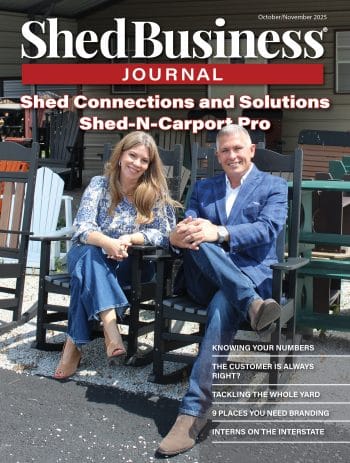A powerful selling tool instilling customer confidence and preventing costly issues.

Customers want complete peace of mind when purchasing products.
And when making a significant long-term investment like a shed, this reassurance comes via a written warranty that shed manufacturers can offer and must fulfill if their sheds fail. Essential to both parties, a warranty is written proof provided to the buyer by a manufacturer to ensure quality.
A shed warranty guarantees that all defects in shed materials that arise separately from normal wear and tear are covered. A warranty should also cover any defects that occur in the shed as a result of poor workmanship.
Matt Housworth, president of Southeastern Portable Buildings in Eatonton, Georgia, says quite simply that warranties, “give consumers confidence in the product and the manufacturer of that product. They benefit builders, dealers, etc., by detailing to the end consumer what to reasonably expect from the product and the terms/limitations that will be honored for such.”
At Eugene, Oregon-based Backyard Buildings, Jorgan Cattin explains that the warranty acts as his company’s assurance of quality craftsmanship, reliable materials, and lasting durability.
“Warranties showcase the builder’s commitment to quality, setting clear expectations for materials and workmanship,” he shares. “[They] drive accountability, encouraging builders to maintain consistently high construction standards and prevent costly issues down the line.
“Warranties instill customer confidence, often becoming a powerful selling tool that differentiates us in a competitive market. When prospects inquire about warranty coverage, it provides dealers with an opportunity to emphasize product quality, demonstrate transparency, and build trust that leads directly to higher closing rates.”
Haulers can indirectly benefit from warranties too.
“These warranties ensure that sheds are built structurally sound and can withstand transportation and installation,” Cattin adds. “This significantly reduces delivery-related damage and customer dissatisfaction.”
SPECIFICATIONS
A shed warranty should specify a period of time when damages will be fixed. This could mean fixing the original shed, replacing a certain part of it, or giving the buyer a completely new shed.
Each warranty has its own conditions. Both parties should read and understand the entire agreement before signing and purchasing. Conditions to look out for include:
- Length of time the warranty will be valid.
- What kind of damages the warranty covers.
- Any evidence the buyer is required to provide.
- Any type of damage that the warranty will not cover.
- Any actions the buyer is required to take.
Nashville-based LP’s SmartSide Trim & Siding warranties cover their LP SmartSide lap, panel, cedar shake siding, trim, fascia soffit, and more. The company offers a 50-year limited warranty for the substrate which includes 100 percent labor and material in the first five years.
“The LP SmartSide product warranty covers hail damage caused by hail up to 1.75 inches in diameter, fungal decay, buckling, and overlay issues including cracking, chipping, peeling, and other rupturing of the surface overlay,” says Jen Stilwell, the company’s shed marketing manager.
“The benefit of product warranties is that builders can build with confidence knowing the product can withstand hail damage up to 1.75 inches in diameter, many weather conditions, and the passage of time. Builders want their customers to be happy—not just for the first year or until the builder warranty runs out. With our competitive warranty, the LP SmartSide portfolio helps offer that peace of mind.”
Are there any parts of a shed product warranty that can be confusing or a point of contention? Yes, there is, says Housworth.
“Certain materials like wood can contract, and swell with heat, cold, and humidity,” he points out. “That is the nature of wood. This can be a point of confusion in regard to some possible warranty situations.
“There are other warranty areas like earth settling and general maintenance. Some things are beyond control of manufacturers and set up personnel. We address this with a Warranty Terms and Limitations Statement. This details limitations and procedures pertaining to warranties.”
CLAIMS HAPPEN
Sometimes the best sheds from the best companies can have a problem. Stilwell explains that when filing a warranty claim with LP, it is the owner’s responsibility to establish—through invoices, receipts, contractor’s billings, or any other form of reliable documentation—the date of installation of the product, ownership of the product by owner, and, where necessary, the purchase price of the affected product.
“LP must also be given the opportunity to inspect the product upon reasonable notice to the customer and must be allowed to enter the property or structure on which the product is installed to complete the inspection,” Stilwell adds.
“We request that if you want to file a warranty claim, contact LP within 30 days of discovering a possible issue with your product and before you begin any permanent repair. You can file a claim by calling [our 800 line].”
Housworth says all warranty claims should be filed immediately by the consumer using the procedure stated by the entity that is offering the warranty, and that the turnaround time for evaluation and filling the warranty if deemed applicable should always be as soon as reasonably possible.
“In order to evaluate warranty claims, it’s always good to get a copy of the retail sales invoice, the wholesale order with delivery ticket, and manufacturing build order,” Housworth adds. “You should use these to verify that it is actually your product and be familiar with the building in question. Also, any delivery pictures recorded by the set-up drivers [should be used].
“Ultimately you will need pictures from the customer of the potential issue. These should be obtained first before contacting the customer who filed the claim so that you can try to do a preliminary assessment before speaking to the customer and sending out personnel. Though some of these items may not be pertinent to the situation, having information at hand and being able to give accurate responses will help give confidence to the consumer.” Ultimately, Cattin believes warranties create a positive feedback loop for everyone involved, elevating brand reputation, increasing sales efficiency, reducing operational risks, and most importantly, ensuring customer peace of mind.




